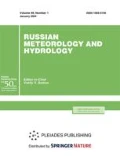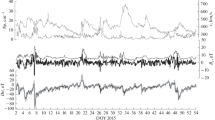Abstract
The potential is investigated of predicting the time series of the Dst geomagnetic index using various adaptive methods: artificial neural networks (classical multilayer perceptrons), decision trees (random forest), gradient boosting. The prediction is based on the parameters of the solar wind and interplanetary magnetic field measured at the Lagrange point L1 in the ACE spacecraft experiment. It is shown that the best prediction skill of the three adaptive methods is demonstrated by gradient boosting.

Similar content being viewed by others
REFERENCES
N. A. Barkhatov, A. E. Levitin, and G. A. Ryabkova, “Artificial Neural Networks for Predicting Geomagnetic Activity Indices Based on Near-Earth Space Parameters,” in Solar-terrestrial Physics, No. 2 (Irkutsk, 2002) [in Russian].
B. M. Vladimirskii and N. A. Temur’yants, Effects of Solar Activity on the Biosphere–Noosphere (MNEPU, Moscow, 2000) [in Russian].
Yu. I. Ermolaev and M. Yu. Ermolaev, “Solar and Interplanetary Sources of Geomagnetic Storms: Space Weather Aspects,” Geofizicheskie Processy i Biosfera, No. 1, 8 (2009) [in Russian].
A. O. Efitorov, I. N. Myagkova, V. R. Shirokii, and S. A. Dolenko, “The Prediction of the Dst Index Based on Machine Learning Methods,” Kosmicheskie Issledovaniya, No. 6, 56 (2018) [Cosmic Res., No. 6, 56 (2018)].
L. L. Lazutin, Global and Polar Magnetic Storms (MGU, Moscow, 2012) [in Russian].
A. L. Chizhevskii, Terrestrial Echo of Solar Storms (Nauka, Moscow, 1973) [in Russian].
V. R. Shirokii, “Comparison of Neural Network Models for Predicting the Geomagnetic Dst Index Based on Different Datasets and Comparison of Methods for the Model Performance Assessment,” in Proceedings of the 17th All-Russian Scientific and Technical Conference “Neuroinformatics-2015” with International Participation, Part 2 (NIYaU MIFI, Moscow, 2015) [in Russian].
S.-I. Akasofu and S. Chapman, Solar-terrestrial Physics (Clarendon Press, Oxford, 1972).
E. Amata, G. Pallocchia, G. Consolini, M. F. Marcucci, and I. Bertello, “Comparison between Three Algorithms for Dst Predictions over the 2003–2005 Period,” J. Atmos. Solar-Terr. Phys., 70 (2008).
N. Barkhatov, N. S. Bellustin, A. E. Levitin, and S. Yu. Sakharov, “Comparison of Efficiency of Artificial Neural Networks for Forecasting the Geomagnetic Activity Index Dst,” Radiophysics and Quantum Electronics, No. 5, 43 (2000).
L. Breiman, “Random Forests,” Mach. Learn, No. 1, 45 (2001).
R. K. Burton, R. L. McPherron, and C. T. Russell, “An Empirical Relationship between Interplanetary Conditions and Dst,” J. Geophys. Res., 80 (1975).
D. G. Cole, “Space Weather: Its Effects and Predictability,” Space Sci. Rev., 107 (2003).
I. A. Daglis, Space Storms and Space Weather Hazards (Kluwer Academic Publ., Dordrecht, 2001).
S. A. Dolenko, Yu. V. Orlov, I. G. Persiantsev, and Ju. S. Shugai, “Neural Network Algorithm for Events Forecasting and Its Application to Space Physics Data,” Lecture Notes in Computer Science, 3697 (2005).
J. H. Friedman, “Stochastic Gradient Boosting,” Computational Statistics and Data Analysis, 38 (1999).
S. Haykin, Neural Networks: A Comprehensive Foundation, 2nd ed. (Prentice Hall, 1998).
N. Iucci, A. E. Levitin, A. V. Belov, E. A. Eroshenko, N. G. Ptitsyna, G. Villoresi, G. V. Chizhenkov, L. I. Dorman, L. I. Gromova, M. Parisi, M. I. Tyasto, and V. Yanke, “Space Weather Conditions and Spacecraft Anomalies in Different Orbits,” Space Weather, No. 1, 3 (2005).
R. Kataoka and Y. Miyoshi, “Average Profiles of the Solar Wind and Outer Radiation Belt during the Extreme Flux Enhancement of Relativistic Electrons at Geosynchronous Orbit,” Ann. Geophys., 26 (2008).
G. M. Lindsay, C. T. Russell, and J. G. Luhmann, “Predictability of Dst Index Based upon Solar Wind Conditions Monitored Inside 1 AU,” J. Geophys. Res., 104 (1999).
R. L. McPherron and T. P. O’Brien, “Predicting Geomagnetic Activity: The Dst Index,” in Space Weather, Ed. by P. Song, H. J. Singer, and G. L. Siscoe (American Geophysical Union, Washington, D.C., 2001).
I. Myagkova, V. Shiroky, and S. Dolenko, “Prediction of Geomagnetic Indexes with the Help of Artificial Neural Networks,” E3S Web of Conferences, 20 (2017).
I. N. Myagkova, Yu. S. Shugay, I. S. Veselovsky, and O. S. Yakovchouk, “Comparative Analysis of Recurrent High-speed Solar Wind Streams Influence on the Radiation Environment of Near-Earth Space in April–July 2010,” Solar Syst. Res., No. 2, 47 (2013).
T. P. O’Brien and R. L. McPherron, “Forecasting the Ring Current Index Dst in Real Time,” J. Atmos. and Solar-Terr. Phys.,62 (2000).
G. Pallochia, E. Amata, G. Consolini, M. F. Marcucci, and I. Bertello, “Geomagnetic Dst Index Forecast Based on IMF Data Only,” Ann. Geophys., 24 (2006).
S. Patra, E. Spencer, W. Horton, and J. Sojka, “Study of Dst/Ring Current Recovery Times Using the WINDMI Model,” J. Geophys. Res., 116 (2011).
T. V. Podladchikova and A. A. Petrukovich, “Extended Geomagnetic Storm Forecast Ahead of Available Solar Wind Measurements,” Space Weather: The International Journal of Research and Applications, 10 (2012).
G. D. Reeves, K. L. McAdams, R. H. W. Friedel, and T. P. O’Brien, “Acceleration and Loss of Relativistic Electrons during Geomagnetic Storms,” Geophys. Res. Lett., 30 (2003).
M. Revallo, P. Valach, P. Hejda, and J. Bochniceket, “Modeling of CME and CIR Driven Geomagnetic Storms by Means of Artificial Neural Networks,” J. Atmos. Solar-Terr. Phys., No. 9, 110 (2014).
C. Schrijver, K. Kauristie, A. Aylward, C. Denardini, S. Gibson, A. Glover, N. Gopalswamy, M. Grande, M. Hapgood, D. Heynderickx, N. Jakowski, V. Kalegaev, G. Lapenta, J. Linker, S. Liu, C. Mandrini, I. Mann, T. Nagatsuma, D. Nandi, and N. Vilmer, “Understanding Space Weather to Shield Society: A Global Road Map for 2015–2025 Commissioned by COSPAR and ILWS,” Adv. Space Res., 2 (2015).
M. V. Stepanova and P. Perez, “Autoprediction of Dst Index Using Neural Network Techniques and Relationship to the Auroral Geomagnetic Indices,” Geofis. int., No. 1, 39 (2000).
M. Sugiura, “Hourly Values of Equatorial Dst for the IGY,” Ann. Int. Geophys., 35 (1964).
J.-G. Wu and H. Lundstedt, “Geomagnetic Storm Predictions from Solar Wind Data with the Use of Dynamic Neural Networks,” J. Geophys. Res., No. A7, 102 (1997).
Author information
Authors and Affiliations
Corresponding author
Additional information
Translated from Meteorologiya i Gidrologiya, 2021, No. 3, pp. 38-46. https://doi.org/10.52002/0130-2906-2021-3-38-46.
About this article
Cite this article
Myagkova, I.N., Shirokii, V.R., Vladimirov, R.D. et al. Prediction of the Dst Geomagnetic Index Using Adaptive Methods. Russ. Meteorol. Hydrol. 46, 157–162 (2021). https://doi.org/10.3103/S1068373921030031
Received:
Published:
Issue Date:
DOI: https://doi.org/10.3103/S1068373921030031




